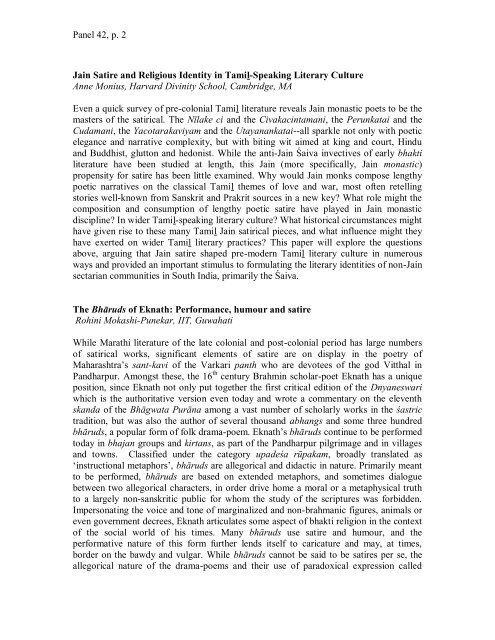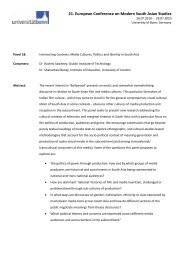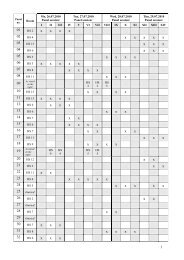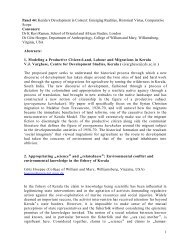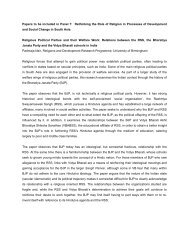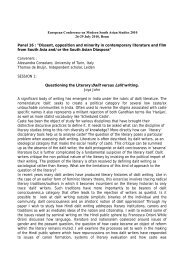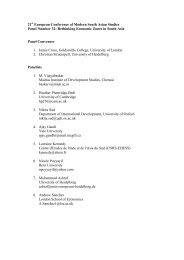Twenty-First European Conference for Modern South Asian Studies,
Twenty-First European Conference for Modern South Asian Studies,
Twenty-First European Conference for Modern South Asian Studies,
You also want an ePaper? Increase the reach of your titles
YUMPU automatically turns print PDFs into web optimized ePapers that Google loves.
Panel 42, p. 2<br />
Jain Satire and Religious Identity in Tamiḻ-Speaking Literary Culture<br />
Anne Monius, Harvard Divinity School, Cambridge, MA<br />
Even a quick survey of pre-colonial Tamiḻ literature reveals Jain monastic poets to be the<br />
masters of the satirical. The Nīlake ci and the Civakacintamani, the Perunkatai and the<br />
Cudamani, the Yacotarakaviyam and the Utayanankatai--all sparkle not only with poetic<br />
elegance and narrative complexity, but with biting wit aimed at king and court, Hindu<br />
and Buddhist, glutton and hedonist. While the anti-Jain Śaiva invectives of early bhakti<br />
literature have been studied at length, this Jain (more specifically, Jain monastic)<br />
propensity <strong>for</strong> satire has been little examined. Why would Jain monks compose lengthy<br />
poetic narratives on the classical Tamiḻ themes of love and war, most often retelling<br />
stories well-known from Sanskrit and Prakrit sources in a new key? What role might the<br />
composition and consumption of lengthy poetic satire have played in Jain monastic<br />
discipline? In wider Tamiḻ-speaking literary culture? What historical circumstances might<br />
have given rise to these many Tamiḻ Jain satirical pieces, and what influence might they<br />
have exerted on wider Tamiḻ literary practices? This paper will explore the questions<br />
above, arguing that Jain satire shaped pre-modern Tamiḻ literary culture in numerous<br />
ways and provided an important stimulus to <strong>for</strong>mulating the literary identities of non-Jain<br />
sectarian communities in <strong>South</strong> India, primarily the Śaiva.<br />
The Bhāruds of Eknath: Per<strong>for</strong>mance, humour and satire<br />
Rohini Mokashi-Punekar, IIT, Guwahati<br />
While Marathi literature of the late colonial and post-colonial period has large numbers<br />
of satirical works, significant elements of satire are on display in the poetry of<br />
Maharashtra‟s sant-kavi of the Varkari panth who are devotees of the god Vitthal in<br />
Pandharpur. Amongst these, the 16 th century Brahmin scholar-poet Eknath has a unique<br />
position, since Eknath not only put together the first critical edition of the Dnyaneswari<br />
which is the authoritative version even today and wrote a commentary on the eleventh<br />
skanda of the Bhāgwata Purāna among a vast number of scholarly works in the śastric<br />
tradition, but was also the author of several thousand abhangs and some three hundred<br />
bhāruds, a popular <strong>for</strong>m of folk drama-poem. Eknath‟s bhāruds continue to be per<strong>for</strong>med<br />
today in bhajan groups and kirtans, as part of the Pandharpur pilgrimage and in villages<br />
and towns. Classified under the category upadeśa rūpakam, broadly translated as<br />
„instructional metaphors‟, bhāruds are allegorical and didactic in nature. Primarily meant<br />
to be per<strong>for</strong>med, bhāruds are based on extended metaphors, and sometimes dialogue<br />
between two allegorical characters, in order drive home a moral or a metaphysical truth<br />
to a largely non-sanskritic public <strong>for</strong> whom the study of the scriptures was <strong>for</strong>bidden.<br />
Impersonating the voice and tone of marginalized and non-brahmanic figures, animals or<br />
even government decrees, Eknath articulates some aspect of bhakti religion in the context<br />
of the social world of his times. Many bhāruds use satire and humour, and the<br />
per<strong>for</strong>mative nature of this <strong>for</strong>m further lends itself to caricature and may, at times,<br />
border on the bawdy and vulgar. While bhāruds cannot be said to be satires per se, the<br />
allegorical nature of the drama-poems and their use of paradoxical expression called


